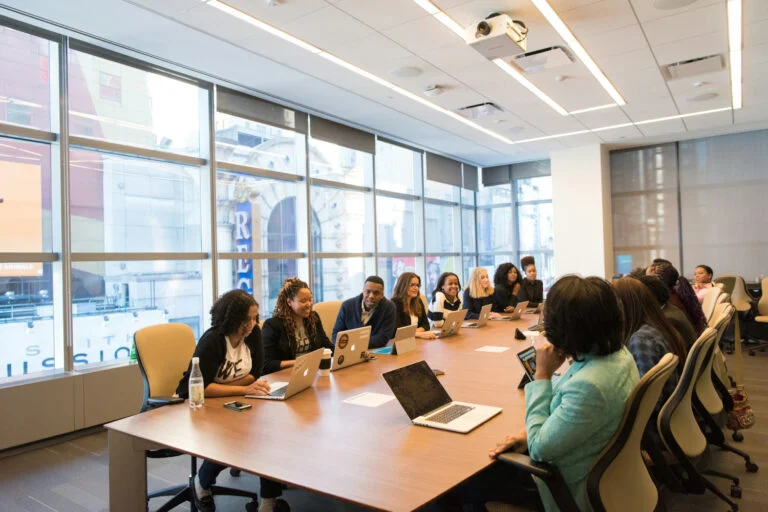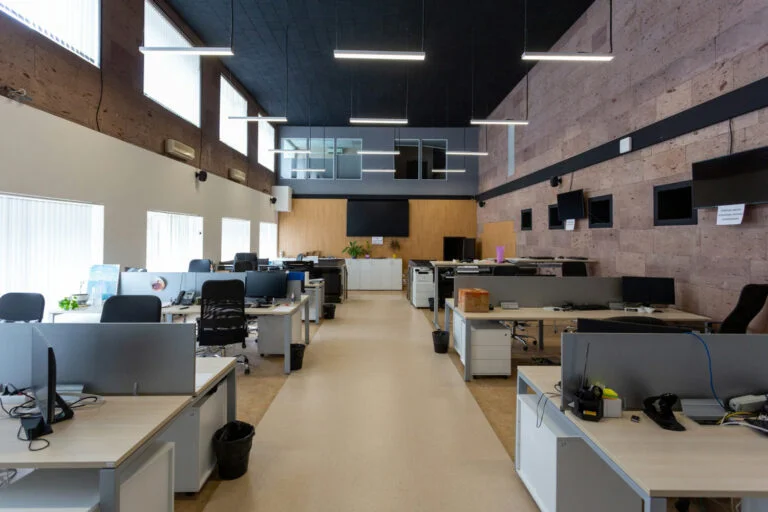The office concept started its existence centuries ago. Since then, it has undergone many adjustments but always corresponded with people's needs. As the world changes, the office space keeps up with it.
No wonder that, after decades of working place transformation, the global pandemic has made an impact on the way we work once again. As businesses adjust to the new operating reality for their employees, it's essential to start with the basics: office floor plan layout.
Types of floor plans throughout the history
In order to come to a modern floor plan approach, office spaces went through multiple stages of evolution. Some concepts go in and out of style, but strategies from any era can be used to create a floor layout that best fits your employees' working style.
During COVID-19, the workplace environment should be based on people's choices, flexibility, and personalization. Exploring all possible options for office layout, you can take the best practices out of each to create an ideal space for your team to work in productively.
The industrial floor plan: the rise of the open-plan office
The open office concept originates in the early to the mid-20th century during the rise of the industrial sector. It was an attempt to create a more spacious place to work in and increase interaction between employees. The open-plan industrial office is characterized by removing any borders (including walls) and linear rows of desks packed to the brim with workers. Such a concept seemed ideal, but in practice, there weren't any gains in interaction as architects had hoped. Instead, it mostly looked like a holdover from a factory-style organization of space.
The Advent of Cubicles
Nowadays, we think of cubicles as an old-fashioned way of organizing office space and one of the worst solutions for productivity. It's hard to believe that the cubicle was made to empower an open layout by adding some privacy to the workplace. People thought it'd optimize productivity and bring an aspect of personalization. One more bright idea that failed in real-life testing. Since the workforce experienced a wave of new employees, the cubicle became smaller and cheaper to minimize costs and fit as many people as possible.
Open office plan is back again
In the late 1900s, the idea of creating a powerful collaborative workspace and making better use of square footage started to spread again. So, the open floor concept drew attention as one of the possible solutions. Despite the disadvantages of open space, its virtues made this approach popular among office culture in the 2000s. And the tech boom, happening the same decade, led to a new transformation of the workspace: nap zones, break rooms, meeting spots, and other social-gathering places started to pop up within the office walls.
Activity-based and hybrid work
The Activity Based Working (ABW) approach implies that people perform different activities during their everyday work routine. So, they need specific work settings supported by technologies and culture to carry out duties efficiently. ABW covers some shortcomings of an open office plan (for instance, noise and distraction) by creating different purpose meeting places for small-team work, team building, booths for solo work, tet-a-tet spots. It also embraces hot desking solutions to achieve flexibility in the office space. This approach, while still imperfect, brings closer to better health and wellness workplace conditions.
Comparing closed and open floor plans
While open and activity-based office layouts are the most popular across the companies now, some industries still prefer to stick with closed floor plans. Why is that so? What are the advantages of each type? Let's dig into it and find out what features could be helpful for your office plan.
Pros and cons of open and closed floor plans
Open office layout pros (cons of the closed):
- Flexibility and customization
Open office design allows you to rearrange the space as often as needed. You can experiment with layout every year to keep things fresh or change it as a company grows.
- Cost
Engineering an open space doesn't require many infrastructures such as walls, doors, separate conditioning systems, which cost a lot of resources. Therefore, such a solution can easily save up money for something bigger!
- Communication
By breaking down walls, you make employees more accessible to each other. This simplifies the interaction between the team and the ideas generation process. Plus, it's easier to build collaborative spaces (meeting rooms, break zones, etc.) for more productive work.
Closed floor plan pros (cons of the open):
- Privacy
Closed offices give everyone their own space to focus on what's important, without getting interrupted by colleagues or ringing phones.
- Healthier for employees
Health safety is essential in our new reality. Closed offices can provide an element of protection if someone at work catches a contagious disease and prevent spread around the workspace.
- Productivity
Without any outside distraction, sitting in your comfort zone, employees work more efficiently and meet all deadlines on time.
Try UnSpot for free
Get a smart solution to manage your hybrid workplace, create work schedules, book desks and meeting rooms, schedule meetings, and get office analytics.
Make the most of your office space during COVID-19
The office format as we knew has changed again with the coming of pandemics into our lives. The shift towards remote work happened so quickly, and now the business world has to adjust to new ways of operating. Companies are rethinking their office layouts to follow safety guidelines COVID-19 requires and trying to figure out a workable model for employees. One of the many debates arising out of the pandemic is how the office should look like considering new reality?
Creating the right floor plan for your office
No doubt, office planning can be a big headache. However, the right design can influence your employees' productivity and increase their satisfaction at the workplace. It's worth investing time and effort in office planning, so a team can feel comfortable and achieve the best results.
There are some important steps to consider when creating a productive, efficient, and pleasing office space.
Evaluate your space and the number of employees
Once you've collected all information about your office and its functioning needs, it's easier to maximize the space utilization for employees.
Here are some questions you need to ask yourself while evaluating place:
- What is the square footage of your office?
- What type of space do you have available? (meeting rooms, break zones, storage)
- How many workers do you have? How often do they visit the office?
- What furniture is in your space? Is it in good or bad condition? Can it be reused to meet the new layout?
- Do you have any seating strategies like hot-desking, desk-hoteling, assigned? If not, do you want to have it?
- How do people use the office? What rooms are the most popular?
Consider how your people get their work done
The right floor plan helps to utilize the space and gives employees a necessary environment to stay productive. Depending on the way your employees get their work done, there are different approaches you can use to adjust the office to a new norm during COVID-19.
- Assigned seating
The traditional desk assignment will be the perfect solution if you have enough room in the office to provide seatings for each team member following distancing guidelines. That way, everyone could have their private spots in the workspace.
- Flexible (hot-desking, desk hoteling)
If employees are traveling a lot or for any other reasons don't visit the office every day, flexible strategies like hot-desking are the best fit option. With a few clicks in a mobile app, your team can book a desk or meeting room when they need it.
- Grouping
To limit the spread of any illness and maintain a safe environment in your office, you can create socially distanced floor plans for teams who work together constantly. Grouping can restrict the number of people each employee sees during a day, which is essential for contact tracing in case of infection.
Find the right tool to manage floor plan
Understanding how your office is being used throughout a day, week, and month help maximize space utilization and efficiency, keep a safe environment for a team, and prevent unpleasant losses in a budget.
Having the right tools at hand, you're in control of the workspace. When choosing ones, make sure they have the following features:
- Desk management
Software should be accessible and allow employees to book a seat on a fly.
- Booking resources
The right tool provides choices of reserving both desks and meeting rooms for a specific date and time with the ability to add attendees.
- Transparent reports
All tools are useless if they're missing a crucial part - the option to analyze received data. With powerful reports, you can make the most out of your office space by considering the right decisions on time and not when it's too late.
Unspot is an all-in-one solution to let you be in charge of available space, find a balance between comfort and safety for employees. Get workspace insights on how to make the most out of the office. Keep your focus on what's important while Unspot takes care of details.









